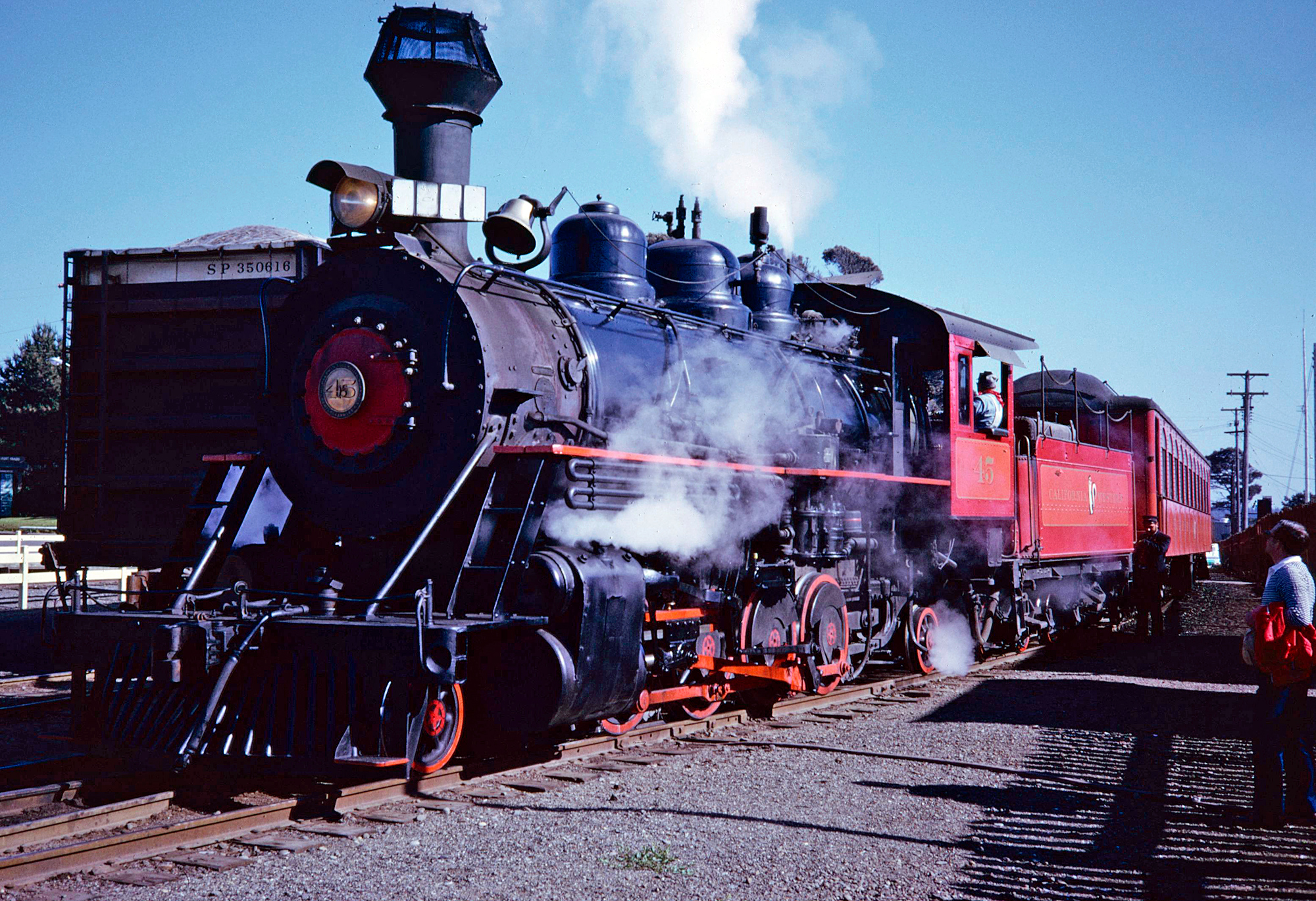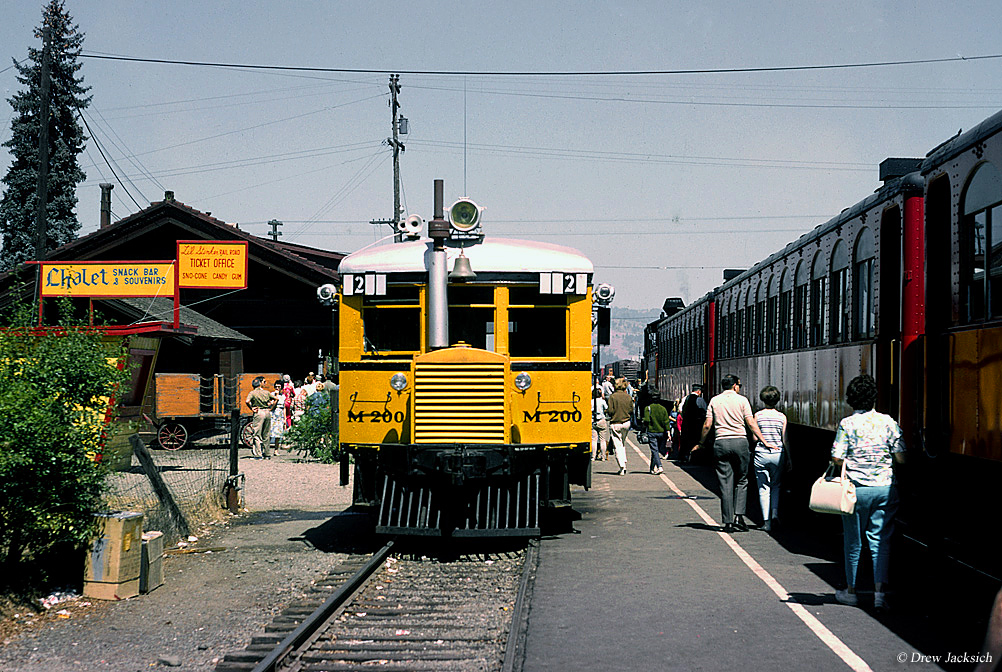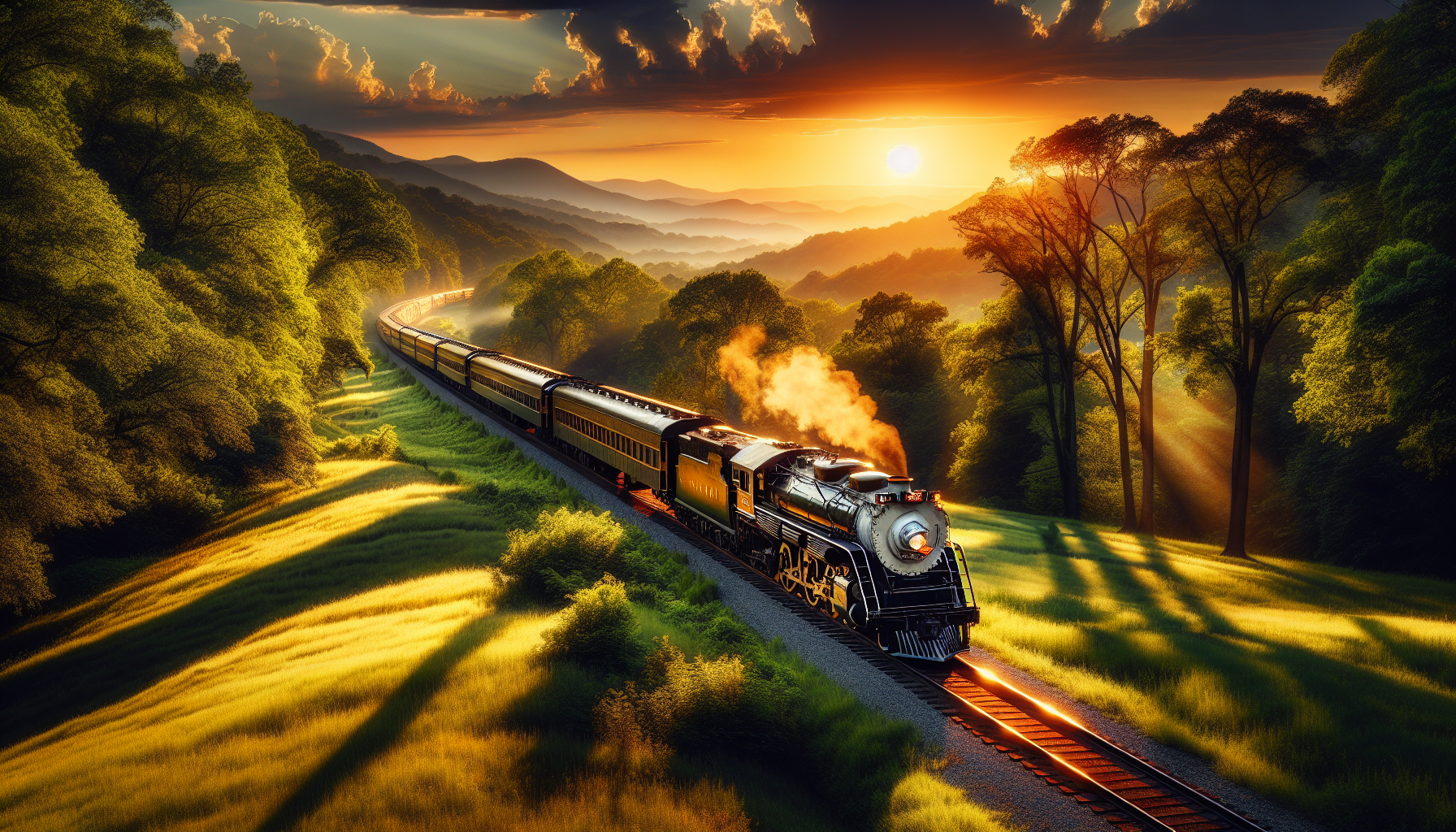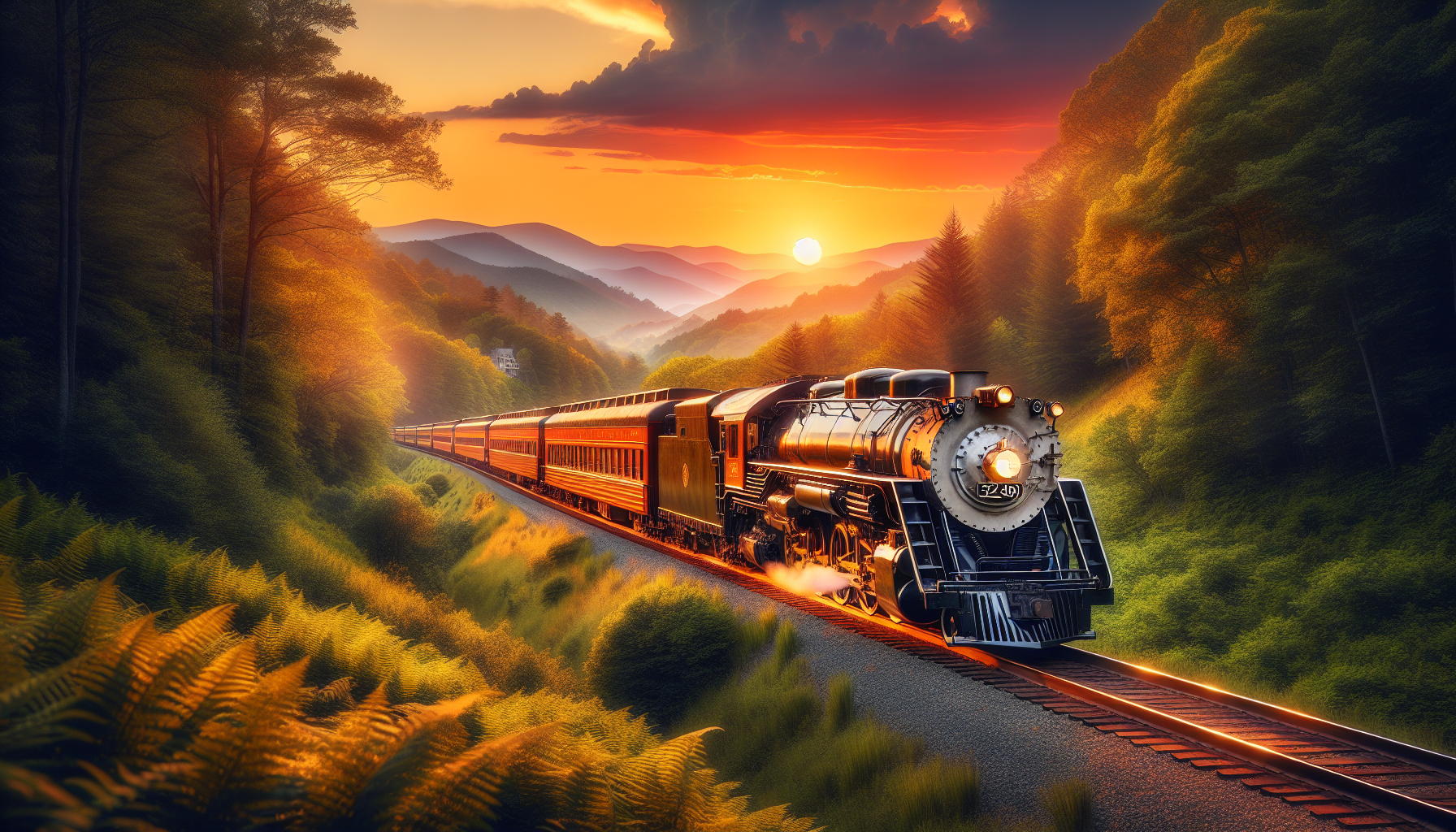The "Skunk Train": The California Western Railroad
Last revised: September 11, 2024
By: Adam Burns
The so-called Skunk Train is the long-held nickname given to California Western's rail buses, first placed in service during the mid-1920's.
Their purpose was to reduce losses of passenger operations while continuing to provide the public with rail transportation.
What became the California Western Railroad (reporting mark, CWR) during the early 20th century began as the Fort Bragg Railroad, formed during the 1880's to handle Redwood logs.
The small town of Fort Bragg, California was the center of all operations where a large mill was constructed.
For many years shipments of redwood lumber was taken out be ship but after the Northwestern Pacific Railroad's completion the California Western met it at Willits in 1911, thus providing through service to San Francisco.
As the years passed the Skunks grew in popularity and the railroad became a noteworthy tourist attraction. In addition, with improved highways, trucks became the primary artery in which logs were moved out of Mendocino County.
Eventually, the railroad was separated from its lumber connections and became wholly dependent on excursionists.
For a time it struggled but came under the Sierra Railroad's ownership in 2003 where it has thrived under the name Skunk Train.
History
The Skunk Train would not be a possibility today if it were not for the region's giant Redwoods and Charles Russell, "CR," Johnson.
The state of California has long been known for its magnificent redwoods, which draw thousands of tourists annually.
Many, though, may not be aware that there are actually two varieties; a coastal and inland species. The former, whose official genus designation is sequoia sempervirens can be found along the Mendocino Coast.
It is somewhat smaller than its larger cousin based within the Sierra Nevada, named sequoia gigantea. Both species are spectacular evergreens that are massive specimens, capable of living for thousands of years.
They also proved quite hearty as a construction material, which brought loggers to the Northern California coastal region situated nearly 200 miles north of San Francisco.
The individual who made it all happen was the previously mentioned CR Johnson.
Born on February 14, 1859 in Racine, Wisconsin he was raised around timber his entire life as his dad was lumberman who owned mills in Saugatuck and St. Ignace, Michigan.
At the age of 14 he was sent to San Francisco. Afterwards he returned to work at his dad's mills he took jobs else to continue learning about the trade.
He decided to return to Northern California in 1881, where he then learned about the giant redwoods of Mendocino County.
He was immediately captivated by them; not only for their monetary potential but also incredible beauty and shear magnificence.
He convinced two individuals who were proficient loggers themselves, Calvin Stewart and James Hunter, to launch a new business aimed at marketing the redwoods.
Together the trio formed the Stewart, Hunger & Johnson Company where they planned to fell trees just north of a former Army outpost abandoned in 1867, Fort Bragg.
Johnson used his expertise from back east to more efficiently harvest the wood for retail sale. The group quickly ran into a problem as they had no usable harbor to and from which ships could safely navigate.
As a result, the former military property was purchased and Johnson formed a new operation, the Fort Bragg Lumber Company. What followed as a series of events which formed the foundation of the modern California Western Railroad.
He first acquired all interests in the Stewart, Hunger & Johnson Company as well as another logging operation, the McPherson & Weatherby Company based along Pudding Creek.
Next, he incorporated the Fort Bragg Railroad on April 30, 1885. It was projected to run 20 miles along the Noyo River as well as contain a northern branch to the Ten Mile River.
Interestingly, unlike many logging operations which constructed private railroads, Johnson established his as a traditional common-carrier, enabling it to haul passengers (a used streetcar from San Francisco was purchased to transport paying customers).
Later that year, on November 16th, the new sawmill in Fort Bragg began operations.
Finally, as a means of establishing a base of operations for his workers, Johnson incorporated the town of Fort Bragg in 1889.
His railroad was built to the standard-gauge of 4 feet, 8 1/2 inches after deliberating over a narrow-gauge, 3-foot system.
Construction efforts were aided by the acquisition of the small Pudding Creek Railroad, a former McPherson & Weatherby property.
By 1887 the Fort Bragg Railroad had been pushed 6.6 miles east of Fort Bragg to a point known as Glen Blair along the Pudding Creek.
Here, another mill was located, owned by the Glen Blair Lumber Company. As operations continued to expand the Union Lumber Company was formed on August 17, 1893 to acquire the Fort Bragg Lumber Company's assets, the White & Plummer Company (which owned many acres of surrounding redwood stands), and the Fort Bragg Railroad.
To continue its push east the railroad was required to bore a tunnel to reach timber tracts along the nearby Noyo River. The 1,122-foot bore was completed in 1893, largely with Chinese labor.
Following a downturn in the U.S. economy, brought about by that year's financial panic, the Fort Bragg Railroad had 10 miles in operation by 1898.
Construction
As the years passed the tracks were slowly extended further east along the river, following the timber in the process; by 1904 Alpine was reached (18.1 miles), a location which became home to the Alpine Tavern, a popular resort attraction.
The following year a major change occurred as Union Lumber sought to greatly expand its rail operations.
As Spencer Crump notes in his book, "The Story Of The California Western Skunk Railroad: Redwoods, Iron Horses And The Pacific," on June 30, 1905 the California-Western Railroad And Navigation Company was born with intentions of maintaining a 65-mile network, which included all main and branch lines.
It acquired all assets of the Fort Bragg Railroad as of July 1st and set about making this a reality.
This was further bolstered by the news of Southern Pacific and Atchison, Topeka & Santa Fe completing a joint effort into Northern California as part of an endeavor to capture a good deal of the lumber trade in the region.
They formed the Northwestern Pacific Railroad (NWP) which opened a 271-mile corridor from Schellville and Eureka by 1907.
- The NWP was comprised by merging several smaller lines (which used different gauges, or the width between the rails, ranging from 3-foot to the standard 4 feet, 8 1/12 inches) the NWP totaled more than 270 miles in length and offered the region's only rail service.
As time passed the Santa Fe dropped its interest and the SP acquired full ownership in 1929. The NWP was operated as a wholly-owned subsidiary of SP until sections were sold off in the 1980s and the entire route was out of the Class I's hands by the early 1990s. -
The nearest point for a connection, thus offering the California Western a direct link with the national rail network, was the small community of Willits.
The same year the NWP was opened, the California Western began efforts to open a connection. There was a brief delay due to another financial panic of 1907 and no further work was carried out for two years.
Finally, the project resumed in 1909 although was faced with incredibly rugged terrain; in one location engineers were forced to twist the line along a series of S-curves to maintain a manageable grade.
As the crow flies the distance was just 1.5 miles yet required more than 8 miles of right-of-way! Another noteworthy area was situated right before the Willits connection.
This town and the community of Burbeck, which the railroad had reached in 1910, was only 5 miles apart if walking in a straight line.
Once again, though, the topography made such an easy jaunt impossible. Engineers was again used a series of twisting S-curves to maintain a suitable grade, which totaled upwards of 12 miles of track.
Along the eastern end of this section, an 795-foot tunnel was also needed. Work on the bore began in April, 1911 and was finished later that same year in November.
The remaining grading went rather smoothly and the first train (carrying 150 passengers) from Fort Bragg to Willits made the journey on December 19, 1911. Altogether, the California Western stretched exactly 40.0 miles.
In addition, it maintained the Ten Mile Branch (completed in 1916/1917) and Glen Blair Railway, both strictly logging operations.
It would be another 7 months, however, before through service was open to the public when the first trains ran on July 4, 1912.
For a brief time, before better highways and roads offered public access into the area via private automobile, Pullman service was offered.
This was initiated in response to the railroad's growing passenger traffic which had jumped from 19,079 in 1918 to 34,585 by 1920. And so, on May 29, 1921 through, overnight Pullman service to San Francisco began.
As a result, traffic peaked at 38,822 by 1923. Afterwards, a slow decline began, which worsened following the Great Depression.
The initial decline was brought about by better roads, which allowed the public to reach the redwoods by way of their own Model T Fords. By 1928, the California Western carried only 20,097 passengers.
Then, the devastating stock market crash of October 29, 1929 nearly wiped out remaining business; by 1931 only 8,720 rode its rails.
Name
Like many railroads, the California Western looked for ways to reduce loses from passenger services. The railroad was then approached by an unlikely source, Mack Trucks, Inc. of Allentown, Pennsylvania.
They pitched the idea of a motorized rail bus featuring a gasoline engine and coach carbody, which, of course, operated on a pair of two-axle trucks with the lead being somewhat smaller.
The company had been in business since 1920 and was somewhat successful. In 1925 the railroad tested its Model ACX, a 35-passenger variant which was 38 feet, 8 inches in length.
After being quite impressed with it, the California Western purchased an example on December 30, 1925 at a price tag of $12,524.
Upon its arrival the railroad immediately modified it by adding 8 feet to the carbody and reducing the seating capacity to 30 in an effort to make it more roomy.
Once given the official designation as M-80 it entered service and proved quite successful despite its odd appearance, which earned it the nickname of Puddle Jumper, Tin Lizzy, Barney Google, and Galloping Goose. There was also another, The Skunk.
Exactly how the M-80 earned this dubious distinction is unknown although a few theories state that kids thought its short snout (which housed the engine) looked like a skunk while another, and most popular version, states, the engine's fumes gave off a very foul odor.
Whatever the case, the name stuck and by the 1930's had caught on with the general public.
By 1933, traffic had rebounded to 18,464 riders, prompting the railroad to acquire another Skunk; #M-100 arrived the following year, a 1926 product of the Edwards Railway Motor Car Company for the Morehead & North Fork Railroad.
Somewhat larger, it was originally designed to handle 41 patrons but was rebuilt by the California Western's shop forces to hold 36 comfortably.
Business during the 1930's peaked at 32,5266 in 1935 but the generally declined through the mid-1940's.
Still, the company continued acquiring rail buses which were a much more efficient and cheaper alternative; in 1941 it acquired another second-hand unit from the Trona Railway with a 50-seat capacity (#M-200) and then picked up the #M-300 in 1963.
This latter unit had been built in 1935 and last worked on the Salt Lake, Garfield & Western Railway (the so-called "Saltair Route").
Following the end of World War II, the Skunk Trains continued to see growing ridership. At 1945 the yearly traffic totaled just 13,717 but had jumped to 22,097 in 1955. By 1962 the number totaled 43,419, more than at any previous point in the railroad's storied history.
In the meantime the railroad continued the most important business of moving redwood logs and finished lumber.
The Union Lumber Company became a major proponent of forest renewal and is single-handedly credited with preserving the giant redwoods.
It quickly realized the younger trees offered the greatest yield and best lumber. In addition to a general love for the species, the company was very selective of the trees it harvested, even as demand grew in the postwar years.
A major name-change took place on January 1, 1948 when the California-Western Railroad And Navigation Company became simply the California Western Railroad as the company dropped all ties to marine transportation.
It was the 1930's when the little short line drew national acclaim when it began to be featured in various magazines and other publications.
The first appeared in the June, 1933 issue of the Brotherhood of Locomotive Engineers' Engineer's Journal where author W.E. Butler covered the Skunks.
It would later be featured in an early issue of Trains Magazine when Squire Knowles covered the operation within the September, 1947 issue entitled "Western-Ho By Railcar."
Of course, these, and other writings had largely been relegated to either railroad or rail fan circles, thus limiting the audience.
That changed in 1959 when the May issue of National Geographic featured a splendid piece on the railroad entitled "The Friendly Train Called Skunk."
It was written by Dean Jeannings and firmly placed the Skunk Trains on the map. The year 1949 proved a watershed, however, in the railroad's storied history.
It acquired its first new diesels that year from Baldwin, a pair of 750 horsepower switchers, which retired the remainder of its steam locomotives (the last was sold in 1956).
Then, in 1969 Union Lumber Company lost its independence when it was acquired by the Boise Cascade Company. This latter entity was later folded into the giant Georgia-Pacific Corporation.
In June, 1987 Georgia-Pacific spun-off the railroad to the Arizona-based Kyle Railways. Nearly ten years later it was again sold when a group of Mendocino Coast businessmen and today the Skunk Train remains a division of the Mendocino Coast Railway.
It was around this time the California Western again became isolated. In 1996 the former Northwestern Pacific line was closed indefinitely and has not operated since, despite efforts to reactive the entire corridor.
Historic Roster
Steam Locomotive Roster
|
Number 1 (Sequoia) 2 (1st) 2 (2nd) 3 4 5 6 7 8 9 11 12 14 21 22 23 36 41 (1st) 41 (2nd) 44 |
Arrangement 0-4-0 2-4-2 0-4-2 2-4-4 4-4-0 4-6-0 0-4-0 2-6-2 4-6-0 Shay (3 Truck) 2-6-2 2-6-2 2-6-2 2-6-2 2-6-2 2-6-2 4-6-0 0-6-0 2-8-0 2-8-2 |
Builder Baldwin Baldwin Baldwin Baldwin Hinkley Schenectady Mason Baldwin Southern Pacific Lima Baldwin Baldwin Baldwin Baldwin Baldwin Baldwin Baldwin Baldwin Baldwin Baldwin |
Date Built 1885 1887 1901 1884 1883 1880 1868 1909 1869 1912 1913 1914 1924 1920 1921 1923 Circa 1890 1901 1920 1930 |
Notes Acquired New Acquired New Ex-California State Belt RR Acquired 1895 Ex-Southern Pacific, Acq. 1895 Ex-Southern Pacific, Acq. 1906 Ex-Santa Fe, Acq. 1908 Acquired New, Numbered 17 in 1924 Ex-Central Pacific* Acquired New Acquired New Acquired New Ex-Fruit Growers Supply Co., Acq. 1938 Acquired New Acquired New Acquired New Acquired New Ex-El Paso & Southwestern, Acq. 1922 Ex-Sierra Railroad, Acq. 1940 Ex-Lamm Lumber Co., Acq. 1944 |
* Acquired in 1910 from Southern Pacific and renumbered 38 in 1924.
Diesel Locomotive Roster
|
Number(s) 51-52 53* 55 56 57 61 62 63 |
Builder Baldwin Baldwin Baldwin Baldwin Baldwin American Locomotive American Locomotive American Locomotive |
Model DS-4-4-750 DS-4-4-1000 RS-12 RS-12 S-12 RS-11 RS-11 RS-11 |
Date Built 8/19/1949 8/9/1949 4/1955, Ex-McCloud River RR #32 4/1955, Ex-McCloud River RR #33 9/1953, Ex-Southern Pacific #1539 4/1959, Ex-Southern Pacific #5849 4/1959, Ex-Southern Pacific #5854 9/1959, Ex-Southern Pacific #5870 |
* Originally built for the U.S. Army Corps of Engineers where it was given road number W8380; acquired in 1956 from the Pan-American Engineering Company.
Rail Bus Roster
|
Number M-80 M-100 M-200 M-300 |
Model ACX 25 6-46 - |
Builder Mack Trucks, Inc. Edwards Railway Motor Car Co. Skagit Steel & Iron Works American Car & Foundry |
Capacity* 35 41 50 57 |
Weight/HP 29,000 Lbs/80 HP 39,000 Lbs/12o HP 41,590 Lbs/150 HP 52,060 Lbs/168 HP |
Date Built 10/19/1923 1925** 1927*** 1935**** |
* The capacity figures denote the manufacturers listed seating numbers.
** Ex-Morehead & North Fork Railroad #200, acquired by the California Western in 1934. Rebuilt with a 150 horsepower Cummins diesel engine by Watson & Meehan in 1946.
*** Built for the Longview, Portland & Northern Railroad. Acquired by the California Western in 1941. It was replaced by a 165 horsepower Cummins diesel engine in 1955 by Watson & Meehan.
**** Originally built for the Aberdeen & Rockfish Railroad and later spent time on the Salt Lake, Garfield & Western ("The Saltair Route"). It was acquired by the California Western in 1963 and rebuilt with a 220 horsepower Cummins diesel engine by Watson & Meehan.
Sources:
Crump, Spencer. Story Of The California Western Skunk Railroad: Redwoods, Iron Horses And The Pacific. Los Angeles: Trans-Anglo Books, 1963.
Roberston, Donald B. Encylcopedia Of Western Railroad History, Volume IV. Caldwell: Caxton Printers, Ltd., 1998.
Kirkland, John F. Diesel Builders, The: Volume Three, Baldwin Locomotive Works. Pasadena: Interurban Press, 1994.
Current Roster
Steam Locomotives
California Western 2-8-2 #45 (Operational. Originally built as Owen-Oregon Lumber Company #3, a 1924 product of the Baldwin Locomotive Works.)
California Western 2-6-6-2 #46 (Restoration planned. Originally built as Rayonier Lumber Company 2-6-6-2T #111 by the Baldwin Locomotive Works in June of 1937. It was acquired by the California Western in 1968. The Mallet was rebuilt for operation on the Skunk Train until 1981.)
Diesel Locomotives
California Western GP9m #64 (Operational. Originally built by Electro-Motive as Texas & North Orleans [Southern Pacific] GP9 #244 in May, 1954.)
California Western GP9m #65 (Operational. Originally built by Electro-Motive as Texas & North Orleans [Southern Pacific] GP9 #245 in May, 1954.)
California Western GP9m #66 (Operational. Originally built by Electro-Motive as Chesapeake & Ohio GP9 #6145 in November, 1956.)
California Western Motorcar #M-100 (Operational. Originally built by the Edwards Rail Car Company in 1925 for the Moorhead & North Forks Railroad.)
California Western Motorcar #M-300 (Operational. Originally built by American Car & Foundry as Seaboard Air Line #2026 in 1935.)
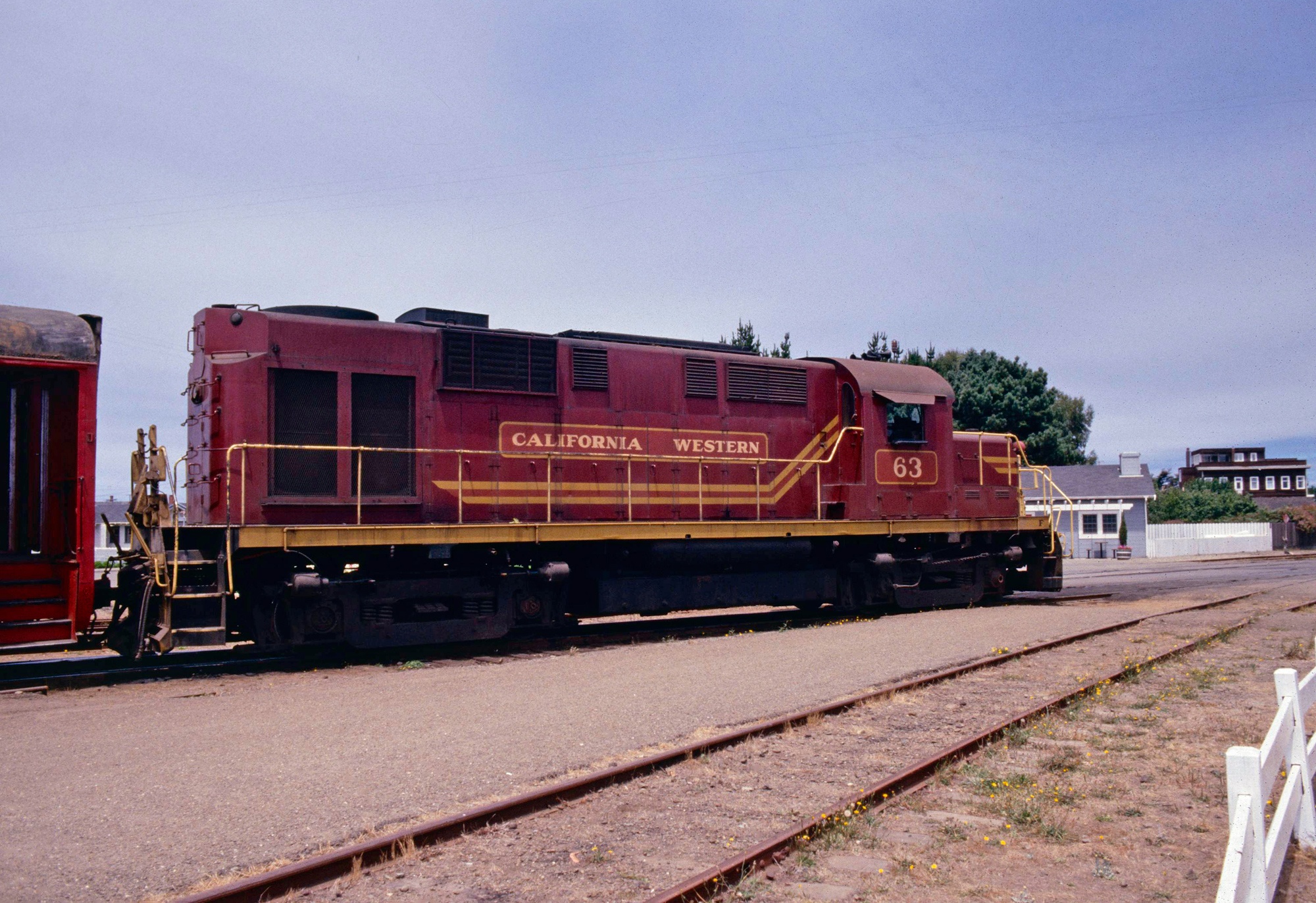 California Western RS-11 #63 is seen here in Fort Bragg, California during July of 1989. Author's collection.
California Western RS-11 #63 is seen here in Fort Bragg, California during July of 1989. Author's collection.In the meantime, as a renewed tourist attraction folks can enjoy riding the Skunk Train's 40 mile line, both steam and diesel powered, passing through small communities along the way such as Pudding Creek, South Fork, Northspur, Burbeck, and others.
There are two notable tunnels on the line including the 1,122-foot Tunnel #1 located a few miles past Fort Bragg and Glen Blair Junction. In addition, another short bore, Tunnel #2 located near Willits that is 795 feet in length.
Thanks to the region's relatively mild climate, situated not far from the coast, the Skunk Train hosts public excursions throughout the year although they do run a reduced schedule during the cooler months in January and February.
In addition to regular excursions they offer special trips, particularly during the holidays such as the Easter Egg Express, Christmas Train, Mother's Day Brunch, and the Halloween Express.
If a connection is reestablished the California Western also hopes to restart freight service if enough business can be garnered. For more information regarding scheduling, pricing, and riding their trains please visit the Skunk Train website.
Recent Articles
-
Tennessee's "Wine Tasting" Train Rides
Aug 16, 25 09:53 PM
One of the most unique and enjoyable ways to savor the flavors of Tennessee’s vineyards is by train aboard the Tennessee Central Railway Museum. -
Oregon's "Wine Tasting" Train Rides
Aug 16, 25 09:49 PM
For those looking to explore this wine paradise in style and comfort, Oregon's wine tasting trains offer a unique and enjoyable way to experience the region's offerings. -
North Carolina's "Wine Tasting" Train Rides
Aug 16, 25 11:29 AM
A noteworthy way to explore North Carolina's beauty is by hopping aboard the Great Smoky Mountains Railroad and sipping fine wine!
